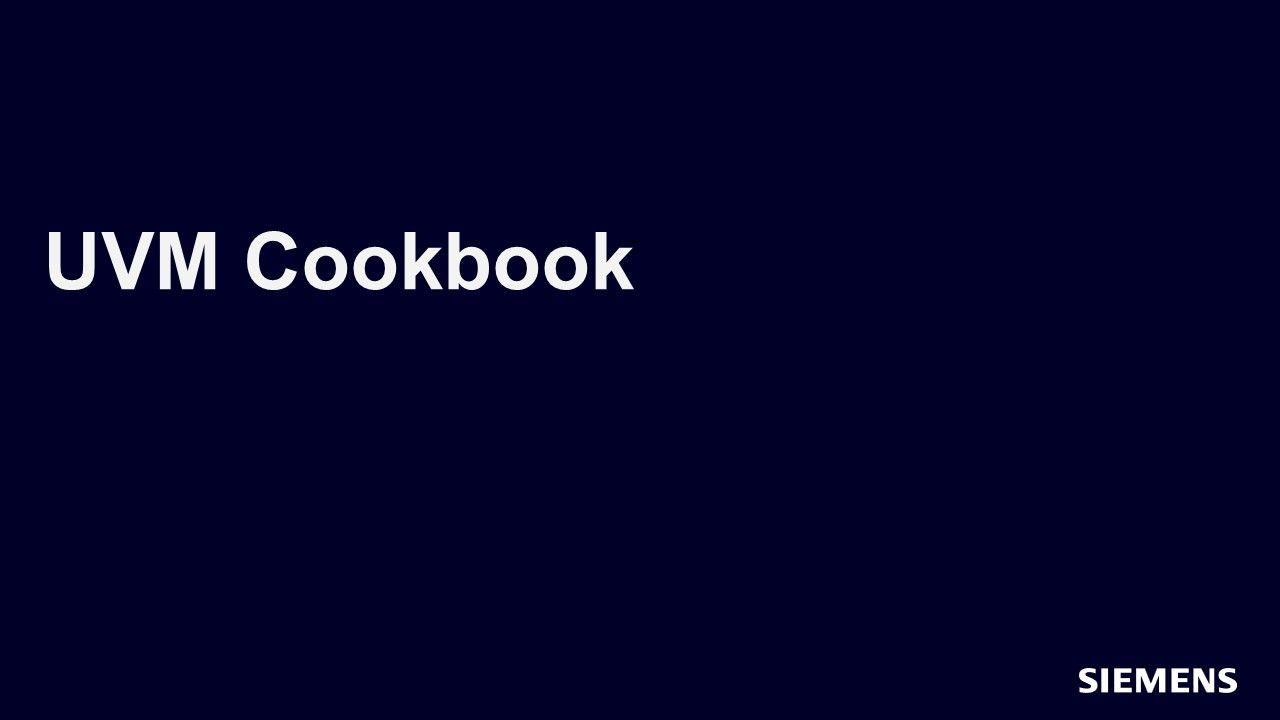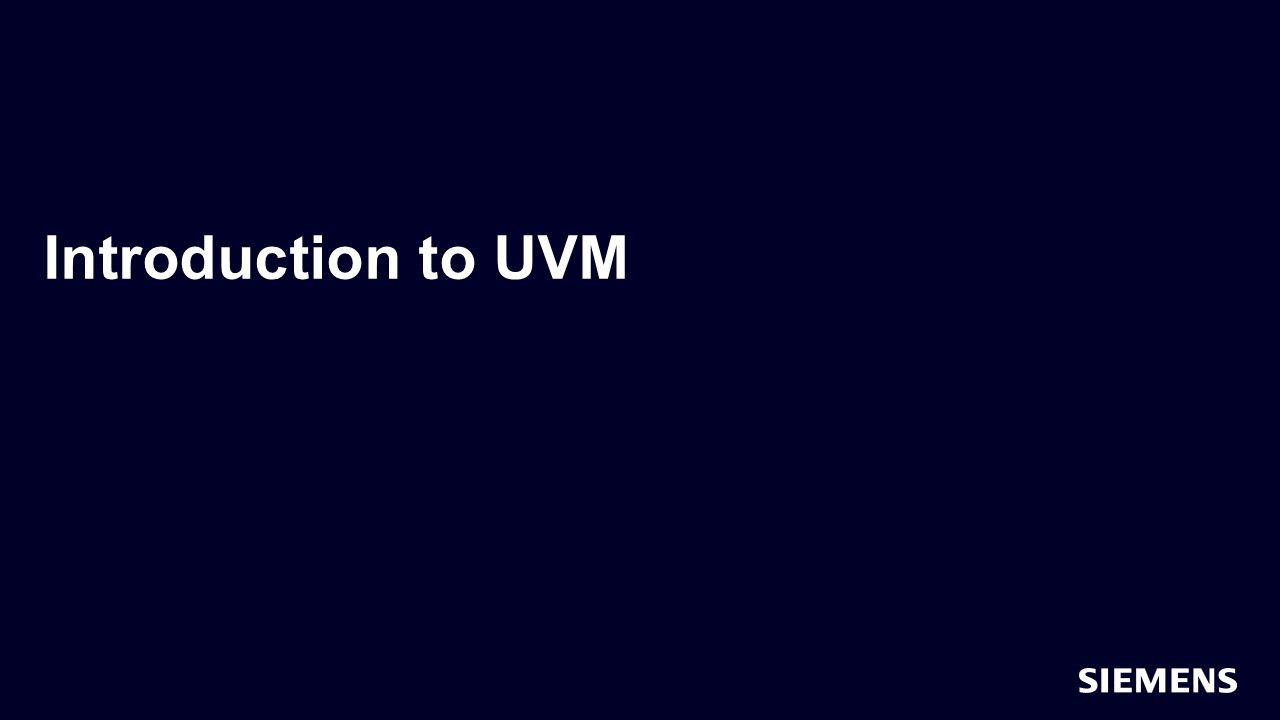UVM - Universal Verification Methodology
The Universal Verification Methodology (UVM) is a powerful framework for designing and verifying complex digital systems, offering significant benefits in terms of reusable and scalable testbenches. UVM promotes reusability by providing a standardized methodology for creating modular, configurable verification components. This modular approach allows engineers to develop testbenches using reusable building blocks, reducing redundancy and saving time.
Furthermore, UVM enhances scalability, enabling easy adaptation to changing project requirements. As designs evolve, UVM's hierarchical and flexible architecture simplifies the addition or modification of testbench components, ensuring efficient and maintainable verification environments. Overall, UVM streamlines the verification process, promoting productivity and ensuring robust, adaptable testbenches.
-

The UVM Cookbook
This newly-updated (2018) version conforms to the IEEE 1800.2 UVM Standard and promotes an emulation-friendly UVM testbench architecture that promotes reuse of your UVM environment as your project moves from simulation to emulation and beyond.
Find all the UVM methodology advice you need in this comprehensive and vast collection.
-
UVM Tracks
-

Functional Verification of Digital Logic
Dive into the world of functional verification with our advanced master’s-level course, developed in collaboration with North Carolina State University. This comprehensive program covers all essential aspects of creating sophisticated constrained-random, coverage-driven testbenches using SystemVerilog and UVM. -

UVM Framework
In this track you will learn more about UVM Framework and how it that provides a reusable UVM methodology and code generator for rapid testbench generation. -

Introduction to the UVM
The Introduction to the UVM (Universal Verification Methodology) course consists of twelve sessions that will guide you from rudimentary SystemVerilog through a complete UVM testbench. -

UVM Basics
UVM Basics will raise a user's level of UVM knowledge to the point where users have sufficient confidence in their own technical understanding that it becomes less of a barrier to adoption. -

Advanced UVM
Advanced UVM builds upon the concepts covered in Basic UVM to take your UVM understanding to the next level. -

UVM Debug
In this track, we examine common UVM debug issues, and provide a systematic set of recommendations to effectively address them. -

UVM Connect
UVM Connect will demonstrate how to reuse your SystemC architectural models and/or reuse SystemVerilog UVM agents to verify models in SystemC.
-
-
UVM Forum
-
UVM Introduction
UVM Introduction
The Universal Verification Methodology (UVM) is a widely adopted and standardized methodology for verifying digital designs and systems. It is a collection of guidelines, libraries, and tools used by verification engineers to create reusable and scalable testbenches for verifying integrated circuits (ICs) and other digital designs. UVM provides a systematic and standardized approach to verification, making it easier to create robust and efficient testbenches.
In this comprehensive overview, we will delve into the key aspects of UVM, including its fundamental principles, the components that make up a UVM testbench, and the numerous benefits it offers in terms of reusability and scalability.
The Need for UVM
Verification is a critical step in the design and development of complex digital systems. It involves verifying that a design meets its specifications and functions correctly under a wide range of operating conditions. Verification engineers are tasked with designing testbenches, which are environments that stimulate the design under test (DUT) with various inputs and monitor its behavior to ensure it complies with the desired functionality.
Without a standardized methodology like UVM, verification engineers often face challenges in terms of efficiency, maintainability, and reusability of testbenches. Each project might require significant effort in developing custom verification environments, which can lead to a considerable amount of duplicated work and inconsistent verification approaches.
UVM's Fundamental Principles
Reusability
One of the core principles of UVM is reusability. UVM promotes the development of modular and reusable verification components, which can be used across multiple projects. These components are known as UVM agents, and they encapsulate functionality for interacting with the DUT. UVM encourages the creation of generic agent classes that can be customized for specific projects. This approach saves time and effort by allowing verification engineers to build on existing components, rather than starting from scratch for each project.
Scalability
Scalability is another essential principle of UVM. A scalable testbench can adapt to the complexity of the DUT, making it suitable for both small and large designs. UVM testbenches are designed in a hierarchical manner, with different layers of abstraction. This hierarchical structure allows verification engineers to focus on specific aspects of the DUT's functionality and performance, while higher-level components handle the overall testbench orchestration. As the DUT's complexity grows, additional components can be added to the testbench, maintaining a structured and scalable verification environment.
UVM Components
To understand how UVM achieves its goals of reusability and scalability, it's essential to explore the key components that make up a UVM testbench.
UVM Agent
UVM agents are the heart of the testbench and provide the means to interact with the DUT. There are two primary types of agents in UVM: the driver and the monitor.
- Driver: The driver is responsible for driving stimulus into the DUT. It converts transactions generated by the testbench into the appropriate signals that are sent to the DUT's inputs.
- Monitor: The monitor, on the other hand, observes the DUT's outputs and converts them into transactions. It checks for errors or violations in the DUT's behavior and forwards this information to other components for analysis.
Each agent typically has an associated sequencer, which controls the generation and ordering of transactions. This separation of concerns allows for flexibility and modularity, as different sequences of transactions can be reused in various agents.
UVM Sequences
Sequences are objects that describe the behavior or scenarios that need to be tested. They encapsulate specific test scenarios, stimulus generation, and expected results. Sequences are independent of the DUT and can be easily reused in different parts of the testbench or across projects.
UVM Scoreboard
The scoreboard is responsible for comparing the actual behavior of the DUT, as observed by the monitor, with the expected behavior specified in the sequences. It checks for discrepancies and raises alerts or errors when the DUT fails to meet its specifications.
UVM Test
A UVM test is a top-level component that orchestrates the execution of sequences, controls the overall flow of the testbench, and manages the reporting of test results.
UVM Environment
The UVM environment ties all these components together, providing a hierarchical structure for the testbench. It manages the configuration of agents, sequences, and other components and ensures that the entire testbench operates cohesively.
UVM Configuration
Configuration objects allow users to customize the behavior of various UVM components without modifying the source code. This feature is valuable for configuring different test scenarios without changing the underlying testbench logic.
UVM Factory
The UVM Factory is responsible for object creation and dynamic typing in UVM. It allows the testbench to create and configure objects based on their types, simplifying object instantiation and management.
Benefits of UVM in Reusable, Scalable, and Interoperable Testbenches
Reusability
Reusable Verification Components
UVM's emphasis on modularity and reusability enables verification engineers to develop a library of generic agents, sequences, and other components. These reusable components can be leveraged across multiple projects, reducing development time and effort. Teams can build upon established building blocks rather than reinventing the wheel for every new project.
Portable Test Scenarios
Since UVM sequences encapsulate test scenarios and are independent of the DUT, they can be easily transported between different projects. Test scenarios that have been thoroughly validated can be reused with confidence in new verification environments. This portability significantly reduces the effort required to create new tests.
Scalability
Hierarchical Structure
UVM's hierarchical structure allows testbenches to scale seamlessly with the complexity of the DUT. New agents, sequences, and other components can be added at various levels of abstraction to accommodate larger designs. This hierarchical approach ensures that verification engineers can manage both simple and highly complex projects efficiently.
Focus on Specific Aspects
UVM encourages verification engineers to focus on specific aspects of the DUT's functionality by using dedicated agents and sequences. This division of labor simplifies the development process, making it easier to test individual features and perform targeted verification.
Incremental Development
Verification teams can adopt an incremental development approach, adding components to the testbench as the design evolves. This flexibility is particularly useful when the DUT undergoes frequent changes, allowing verification to keep pace with the development process.
Interoperability
UVM promotes interoperability by providing standardized interfaces for components. Since UVM components adhere to common interfaces, they can be mixed and matched in various configurations to address different verification challenges. This interoperability extends to third-party tools and simulators that support UVM, allowing for a broader ecosystem of verification solutions.
Improved Debugging and Analysis
UVM's standardized approach to verification simplifies debugging and analysis. Testbenches built using UVM are often equipped with advanced debugging features, such as transaction-level recording and analysis. This enhances visibility into the DUT's behavior, making it easier to pinpoint issues and root causes.
Community and Industry Support
UVM is not just a methodology; it's a standardized framework supported by a wide community of users and the industry. This means that verification engineers can tap into a vast pool of knowledge and resources, including online forums, user groups, and training materials. Industry support ensures that UVM remains a relevant and enduring methodology.
Conclusion
The Universal Verification Methodology (UVM) is a standardized approach to verification that promotes reusability and scalability in the creation of testbenches for digital designs. UVM's core principles of reusability and scalability, along with its standardized components, enable verification engineers to build efficient and maintainable testbenches. The benefits of UVM include improved reusability, scalability, interoperability, debugging capabilities, and access to a supportive community.
While UVM has its learning curve and challenges, it remains a vital methodology in the field of digital design verification. As the complexity of digital designs continues to grow, UVM's emphasis on modularity, reusability, and hierarchical structuring becomes increasingly essential for efficient and effective verification processes. With ongoing industry support and a wealth of resources available, UVM continues to play a central role in ensuring the functionality and reliability of integrated circuits and digital systems.